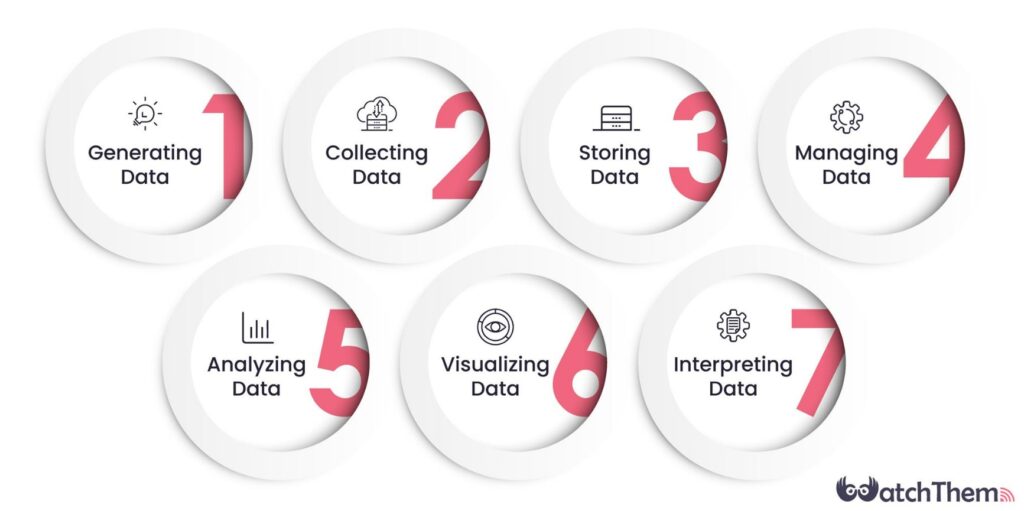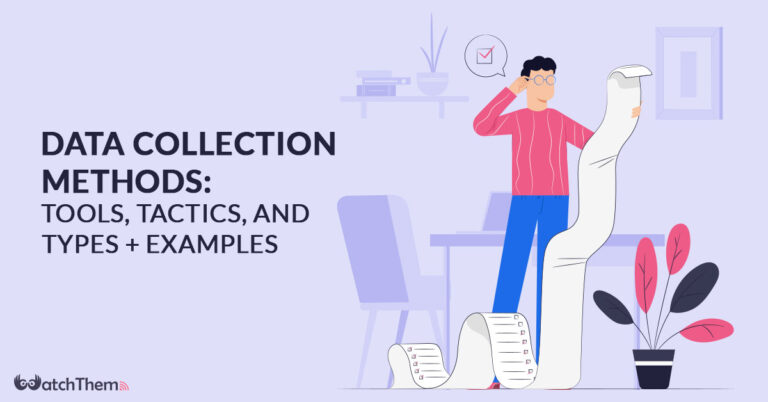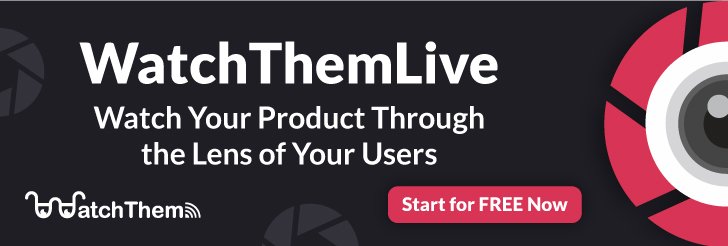Page Contents
The importance of having and gaining knowledge is no secret; knowledge is everything, and data is knowledge in a digitized form. Data has become an extremely important factor since the age of technology. You need it to gain insights about a specific topic and to perform research. Data is an inseparable component of our world today, but to gain the required data, you first need to collect it. There are different ways of collecting data; still, many people only think of a quick Google search when it comes to collecting data for research. In this article, we aim to explain the most common types of data collection. Keep on reading.
Note: WatchThemLive is a remarkable behavior analytics tool that can track user behavior data and give you insights by visualizing your users’ journey through heatmaps and session replays. If you don’t have time to read the whole article, sign up and start collecting data now!
What Is Data?
Data is referred to all the collected measurements and observations that are used as a source of information. In general, there are three types of data:
- First-party data: Collected directly from your own organization’s staff and customers.
- Second-party data: Another company’s first-party data which is shared with your organization.
- Third-party data: The data you buy from other organizations that do not have a direct connection with customers.
The data you are gathering, regardless of its type, can be also categorized into quantitative data and qualitative data. Quantitative data is based on numbers, while qualitative data mainly concerns qualities or characteristics. It is true that for different cases you need to use different types, but you can use either type for many data collection methods.
Every piece of data goes through some steps before it is ready to be used in your organization. You can see the steps below:


Collecting Data For Research
There are several methods of data collection in research; we are going to dive a bit deeper into the most common methods. The first five data collection methods are primarily used for collecting quantitative data, and the second ones are used to collect qualitative data. However, we can use some methods for collecting both qualitative and quantitative data.
Before going through the methods, let’s take a quick look at the table of Quantitative data vs. Qualitative data to review their differences.
Quantitative Data Collection Methods
The quantitative data collection method is the collection of numerical data with statistical significance. You can see some common methods of quantitative data collection here.
1- Experiments
An experiment is one of the most effective methods of data collection. As a researcher, you should change some variables and observe what changes other variables experience. Those variables that you change are called independent, and those that change as a result of manipulation are called dependent variables.
2- Close-Ended Surveys
Surveys are designed to be used for both qualitative and quantitative data collection methods. If it is a close-ended one, you can use the collected data for a quantitative method, and on the contrary, an open-ended one suits the qualitative method.
A close-ended survey is a data collection method that is based on sets of questions that have predefined answers. It means that the answers are either limited to a simple “yes or no”, or they are in the form of multiple-choice questions.
3- Polls
There are different data collection methods and polls are known as one of the best and easiest methods. A poll is a type of data collection in which the researcher asks one single question of respondents (polls are normally limited to one question but come with a couple of follow-up questions.) Since polls generally have a short answer and there is no demographic to interpret, they are considered as easy analysis methods.
4- Questionnaires
A questionnaire is a part of a survey. A survey is designed to ask questions and collect and analyze the data; questionnaires, on the other hand, have nothing to do with the analysis; it is simply a set of written questions designed to collect information. Questionnaires are easy to plan and are economical. You can ask the questions face-to-face, on the phone, or using online social apps.
5- Existing Documents and Records
In this data collection method, you, as a researcher, can use the existing data. The researcher can use databases, meeting minutes, reports, attendance records, financial records, etc.
These types of data collection are highly efficient and inexpensive as the researcher is using the data that has already been collected.
Qualitative Data Collection Methods
Qualitative data is the conceptual and descriptive data that is normally gathered through interviews. The main purpose of the qualitative data collection method is to qualify or characterize the data,
1- Interviews
Interviews are the most well-known method of qualitative data collection that involve asking people questions in order to collect data. Interviews are typically face-to-face questions and answers; depending on the type of questions that the researcher designs, the collected data can be qualitative or quantitative, but they are best suited for the qualitative method. There are different types of interviews including structured, semi-structured, and unstructured.
Interviews are- to some extent- expensive and time-consuming.
2- Focus Groups
Similar to interviews, focus groups consist of talking to respondents face-to-face about a specific topic; the only difference is that there are two or more respondents in a focus group method. The researchers usually use this method when interviews are too time-consuming to schedule. Another usage is for the time you need information about a specific group of people; for example, you want to gather data about your latest product and its impact on a particular group of people.
3- Direct Observation
Another data collection method is through observing people interacting with your product, or website. You can directly see if your user experience is challenging or if there is any problem, in real time. Direct observation is the collection of data when you are gathering it based on the way you interpret the event or answer. You can observe and monitor activities, behaviors, and all other aspects and finally come up with a conclusion.
4- Case Studies
A case study is a type of research that the researcher is supposed to analyze a combination of multiple qualitative data and come to conclusions. The case studies approach is to generate an in-depth understanding of an issue in a real-life context. Most scientists use this qualitative data collection method.
5- Open-Ended Surveys
Open-ended surveys let the respondents to answer the way they want and they are not limited to predefined answers; they can answer freely and as long as they desire. An open-ended question might be like “why don’t you exercise regularly?” and you will probably face different and unique responses.
Data Collection Tools of 2022
Data collection tools are software programs that can gather and analyze the collected data instead of a researcher. These tools can make the whole data collection process easier, faster, and less expensive. We will talk about some tools and their usage below.
1- WatchThemLive
I believe the most effective way to collect data is by hiring website analytics software. Web analytics can assist you in gathering both quantitative and qualitative data. Using web analytics lets you access data such as your website page views, the average time users stay on your website, bounce rate, etc. This data can be collected even in your absence, and it is accurate and reliable; so you are actually collecting the data you want without spending much money, it is a 24/7 process, and your data is ready with no trouble. The best features you can use for data collection are session replays, heatmaps, and website analytics.
Session Replays
Session replays are real-time videos captured from users’ interactions, including clicks, mouse movements, scrolls, etc., and they are used to collect qualitative data. WatchThemLive is the best tool that can offer you the ideal session replays you are looking for. Watch this video to learn more about this amazing feature.
Heatmaps
Heatmap is a method for data visualization in which different colors are used to visualize the collected data. Heatmaps are used to collect quantitative data. They can track where on your website users click the most (or the least) and how far down they scroll.
Website Analytics
Website analytics is collecting and analyzing your website’s data in order to measure its effectiveness and performance. Website analytics also inform you of your users’ behavior across web pages.
2- Zonka Feedback
Zonka Feedback is another tool for data collecting. This app enables you to develop questions and gain insights into customers’ experiences. This app also allows you to generate reports of collected data, have offline access, and can be set for different languages.
3- Forms On Fire
Forms On Fire is basically used to transform the research document into a digital format. This mobile app can be used online or offline, and it also provides templates that you can use to enter the data you gathered and share it with others. In addition, Forms On Fire is a great help for researchers and analysts who work in a team.
4- Dovetail
Dovetail is a customer research platform, and it offers different tools; markup is what we need for analyzing qualitative data. Dovetail provides charts that you can use to measure qualitative data and features that make the data more understandable. For example, it can find meaningful patterns in textual data, transcribe recordings, run sentiment analysis, etc.
5- Kobo Toolbox
Kobo Toolbox is a free and open-source tool for data collection and analysis which is used for mobile data gathering; the app enables you to create and send offline forms. You can either enter the data through their website or via an android application. Then, you can simply visualize and share the collected data.
Conclusion
To wrap it up, we now know that there are different data collection methods for quantitative data and qualitative data. What matters here is to choose the proper methods of data collection. For instance, you can choose questionnaires if you have adequate time and seek to reach specific information, and you can use polls if you need a short and quick answer. Still, if you’re not sure which method to use, you can always ask a professional for help or make use of tools. Our number one suggested tool is WatchThemLive, as it is a user-friendly, cost-efficient, and totally reliable tool that provides its user with a wide range of features. Sign up for WatchThemLive and see how it works today!


